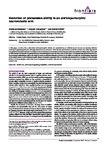Evolution of prehension ability in an anthropomorphic neurorobotic arm.
| dc.contributor.author | Massera, G | en |
| dc.contributor.author | Cangelosi, A | en |
| dc.contributor.author | Nolfi, S | en |
| dc.date.accessioned | 2017-06-02T12:51:41Z | |
| dc.date.available | 2017-06-02T12:51:41Z | |
| dc.date.issued | 2007 | en |
| dc.identifier.uri | http://hdl.handle.net/10026.1/9409 | |
| dc.description.abstract |
In this paper, we show how a simulated anthropomorphic robotic arm controlled by an artificial neural network can develop effective reaching and grasping behaviour through a trial and error process in which the free parameters encode the control rules which regulate the fine-grained interaction between the robot and the environment and variations of the free parameters are retained or discarded on the basis of their effects at the level of the global behaviour exhibited by the robot situated in the environment. The obtained results demonstrate how the proposed methodology allows the robot to produce effective behaviours thanks to its ability to exploit the morphological properties of the robot's body (i.e. its anthropomorphic shape, the elastic properties of its muscle-like actuators and the compliance of its actuated joints) and the properties which arise from the physical interaction between the robot and the environment mediated by appropriate control rules. | en |
| dc.format.extent | 4 - ? | en |
| dc.language | eng | en |
| dc.language.iso | eng | en |
| dc.subject | adaptation | en |
| dc.subject | evolutionary robotics | en |
| dc.subject | reaching and grasping | en |
| dc.subject | robotic arm | en |
| dc.title | Evolution of prehension ability in an anthropomorphic neurorobotic arm. | en |
| dc.type | Journal Article | |
| plymouth.author-url | https://www.ncbi.nlm.nih.gov/pubmed/18958275 | en |
| plymouth.volume | 1 | en |
| plymouth.publication-status | Published online | en |
| plymouth.journal | Front Neurorobot | en |
| dc.identifier.doi | 10.3389/neuro.12.004.2007 | en |
| plymouth.organisational-group | /Plymouth | |
| plymouth.organisational-group | /Plymouth/Faculty of Science and Engineering | |
| plymouth.organisational-group | /Plymouth/Research Groups | |
| plymouth.organisational-group | /Plymouth/Research Groups/Institute of Health and Community | |
| plymouth.organisational-group | /Plymouth/Research Groups/Marine Institute | |
| dc.publisher.place | Switzerland | en |
| dcterms.dateAccepted | 2007-10-12 | en |
| dc.identifier.eissn | 1662-5218 | en |
| dc.rights.embargoperiod | Not known | en |
| rioxxterms.versionofrecord | 10.3389/neuro.12.004.2007 | en |
| rioxxterms.licenseref.uri | http://www.rioxx.net/licenses/all-rights-reserved | en |
| rioxxterms.licenseref.startdate | 2007 | en |
| rioxxterms.type | Journal Article/Review | en |


